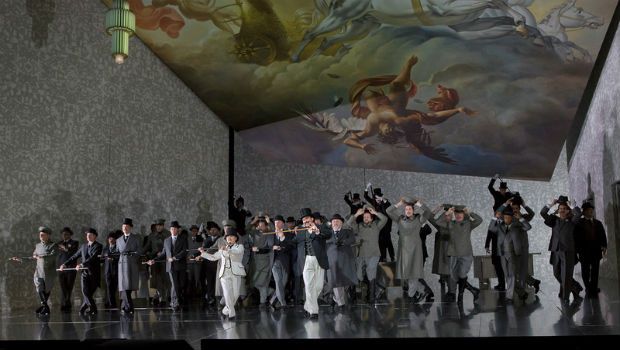Monumental verisimilitude is the hallmark of the Met's Aida, designed by Sonja Frisell on a deliberately grand scale. Those who like an Aida production to be reminiscent of the Egyptian wing at the Metropolitan Museum of Art will not be disappointed. Once dutifully parked, Tuesday night's cast of singers sang strongly and well. Thanks to their fine work and that of the orchestra under Fabio Luisi, the evening had minimal bombast and genuine musical excitement, though the careful attention to realistic detail lavished on the wall paintings was absent from the Personenregie.
Tuesday, November 27, 2012
Sunday, November 25, 2012
Un Ballo in Maschera: Nell'ombre si matura
 |
| The recklessness of frivolity: David Alden's dark Ballo (Act I) |
In Alden's production, it is the recklessness of Gustavo (his hamartia) which drives the action. The pleasure-loving and self-dramatizing monarch flirts with the contempt of the conspirators, openly mocks the insight and the power of Ulrica (clearly he's never read the classical dramatists), dismisses his friend's advice and undervalues his courage, and isn't even particularly interested in understanding Amelia. The frivolous page, Oscar, is established as a sort of alter ego to the king: he is an Icarus figure in the staged prelude and at the masked ball, expressing his monarch's emotional states throughout. Alden emphasizes Gustavo's flaws, but does not neglect his genuine generosity, which is praised by all in the denouement. The moods and morals of the evening having been expressed in shades of grey, I was surprised by the light-flooded triumphalism of the finale, but like many an old Hollywood ending, this one leaves the future uncertain. Incidentally, the sinister splendors of the final scene (think Litvak's Mayerling
Tuesday, November 20, 2012
Er läuft wie ein offenes Messer durch die Welt: Salonen leads Wozzeck at Lincoln Center
 |
| Twentieth-century trauma: Simon Keenlyside as Wozzeck Photo (c) Lincoln Center/Stephanie Berger |
Monday, November 19, 2012
Drama queen(s): Joyce DiDonato at Carnegie Hall
My deep affection for mezzo-soprano Joyce DiDonato is one of this blog's most open secrets. I wasn't sure, however, what to expect of her voice in the baroque arias and scenes which form the material of her newest CD
Monday, November 12, 2012
Godiam, godiam: Richard Tucker Gala 2012
No small part of the Richard Tucker Gala's charm lies in its oddities and incongruities. An endearingly informal introduction embraces the audience as an almost timeless opera-going community, in a tone suited to a gathering of friends. The gala itself, filled with singers fortuitously present in New York City, presents a cornucopia of opera excerpts with no clear organizing principle, except perhaps the preferences of the singers. This year, honoree Ailyn Pérez thoroughly charmed an audience who seemed determined to express their rapture by applauding not only early and long, but also in the middle of scenes. Members of the Met orchestra played with noisy gusto for Patrick Summers, whose efforts at keeping orchestra and singers in sync were not always successful. Out of this cheerful chaos, Gentle Readers, I have distilled several lessons.
Friday, November 9, 2012
Per sistema infedeli, per genio capricciosi: Le Nozze di Figaro
It turns out that a sublime "Contessa, perdono" covers a multitude of sins. But the slipshod slapstick dominating this revival of Le Nozze at the Met has much to atone for. Politics were all but absent from the stage, and subtlety was in sadly short supply. Scarcely an opportunity for broad comedy or bawdy flirtation was passed over; while the first was merely tiresome, the latter, without a clear dramatic function, threatened to be merely confusing. Although the events of the "folle giornata" verged dangerously close to the episodic, the evening did have its strengths. David Robertson led a fleet, attentive account of the score, and the orchestra contributed much-desired emotional tension and nuance to the performance. Some issues of stage-pit synchronization were outweighed, in my view, by this considerable gain. The performances of the women were stronger than I had feared (cf. Zerbinetta's earlier report) but the more convincing performances belonged to the men, with Gerald Finley's Count a standout. The final scene brought me, if temporarily, from a somewhat detached and slightly disgruntled audience member to a helplessly weeping, delighted participant in Mozart and Da Ponte's glorious celebration of forgiveness. The bizarre lights on the tilting facade of the palace (originally intended to be fireworks with undertones of French Revolution?) distracted me again, but there was that moment, and I cherish it.

